App to Keep Track of Study Hours
Whether you're a student or a professional, it can be tricky to stay on top of all the things you have to do. If you let all this information swirl around in your head, you'll end up stressed and frantic.
There is a solution, however: use an external system. When you take your to-do list out of your head and into the right app, you'll free up your brain to spend more time on important tasks and less time on trying to remember that one thing you were supposed to do.
Choosing the right app can be tricky, however, which is why we've done the work for you. Below, we review the 12 best to-do list apps of 2021 – including pros and cons for each. This way, you can spend less time researching and more time being productive!
1. Todoist
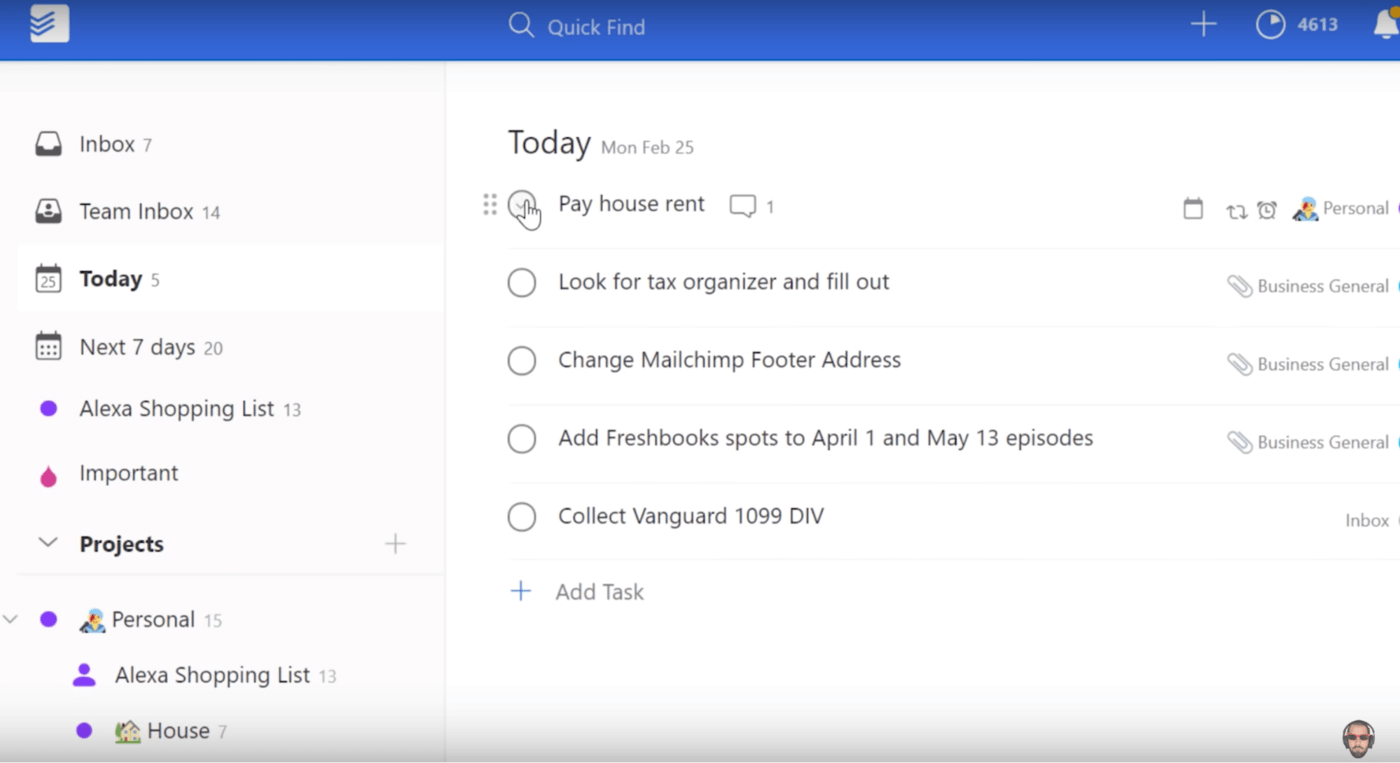
Overview
Todoist is the app that much of the team here at CIG uses. It has a fairly minimalist interface, yet it still packs a lot of power with its tagging and natural language processing features.
Compatibility
- Browser
- Mac
- Windows
- Android
- iOS
- Chrome
Pricing
- Free tier (limited features)
- Premium tier at $4 per month or $36 per year (70% off for students, though)
Pros
- Best app for natural language processing. Categorize tasks with due dates, tags, and projects while you type as fast as you think. No other app beats Todoist in this category.
- Sweet spot between power and flexibility. With projects, labels, filters, and priorities, you can tailor Todoist to your personal workflow, all while being intuitive to pick up and use. This is why Todoist is recommended by so many productivity experts as an entry-level tool, and even has courses designed with it in mind.
- Quick add from everywhere. Todoist lets you add tasks from pretty much anywhere you can be online. In addition to being available on all the mobile app stores, Todoist has native apps on both Windows and Mac, a Chrome extension, and integrations with Gmail and Outlook.
- Siri and Amazon Echo integration. "Alexa, add buy Tesla Model Y in 2021."
Cons
- Subtasks don't work well. Among other complaints, Todoist doesn't let you indent subtasks in its Inbox view. WTH. (Honestly, Todoist! Even the barest option — Google Tasks — has a more intuitive native subtasks function than you do.)Some folks from Todoist contacted me after this post went live and they said that they're working on making subtasks better! Keeping my fingers crossed.
- Windows app isn't as good as the Mac app. This probably applies to a lot of apps. But the UI for Todoist's Windows app doesn't work quite as well as the mobile or Mac apps.
- Creating custom views or lists take some fiddling. Todoist has a built-in Today and Next 7 days view, but if you want to see your school tasks due the next week without worrying about the tasks for your part-time job, then it'll take some fiddling with Todoist's filters.
- $36 per year. If you go with Todoist, you'll probably need to get the premium option to get the advanced flexibility of filters, priorities, and calendar syncing. (There's a student account that goes for ~$1.50/month, though.)
Curious how your to-do list app fits into a larger productivity system? Check out this guide to staying organized in college.
2. TickTick
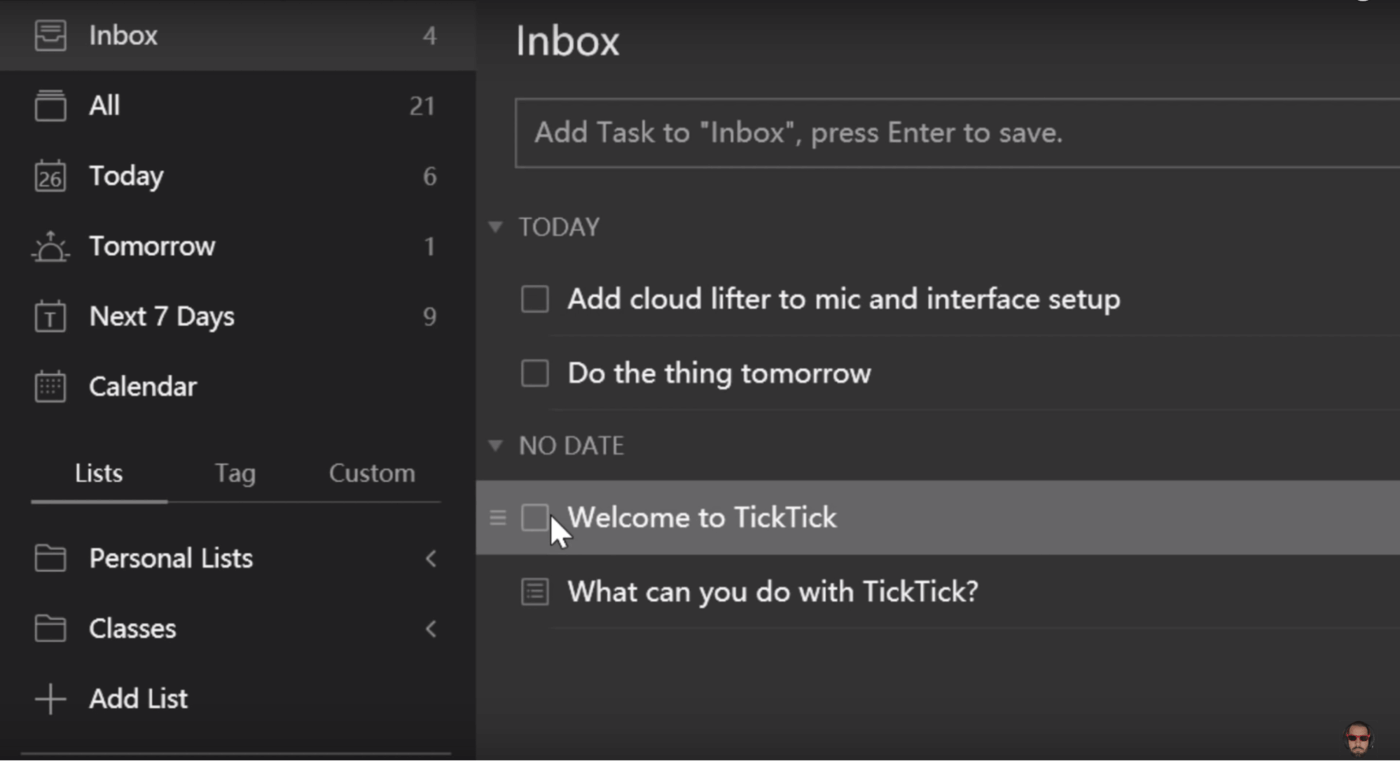
Overview
TickTick is quite similar to Todoist, with a nearly identical interface. It does offer some features that Todoist lacks, such as a built-in Pomodoro timer and calendar view.
Compatibility
- Browser
- Mac
- Windows
- Android
- iOS
Pricing
- Free tier (limited features)
- Premium tier at $28 per year or $2.79 per month
Pros
- Cheaper than Todoist (for almost-equal functionality). TickTick positions itself as a direct competitor to Todoist. At $28 a year it delivers most of Todoist's features at almost half the price, plus some things Todoist doesn't have like custom views (a.k.a. smart lists) and a built-in calendar view.
- Lots of delightful productivity extras. TickTick has a built-in Pomodoro timer that ties to specific tasks. It lets you choose to add a new task to the beginning or the end of a list, and it lets you set start times and due dates. It even has a habit tracker and a white noise generator on mobile.
- "Plan My Day" feature. Pulls up tasks with due dates on them to help you decide what to work on for the day.
Cons
- No native calendar sync. You'll have to get the premium plan and fiddle with links to sync your current calendar with TickTick.
- Super limited free plan. The free plan limits you to 9 lists, 99 tasks per list, and 19 subtasks per task. No calendar syncing or anything fun like that.
3. Microsoft To-Do
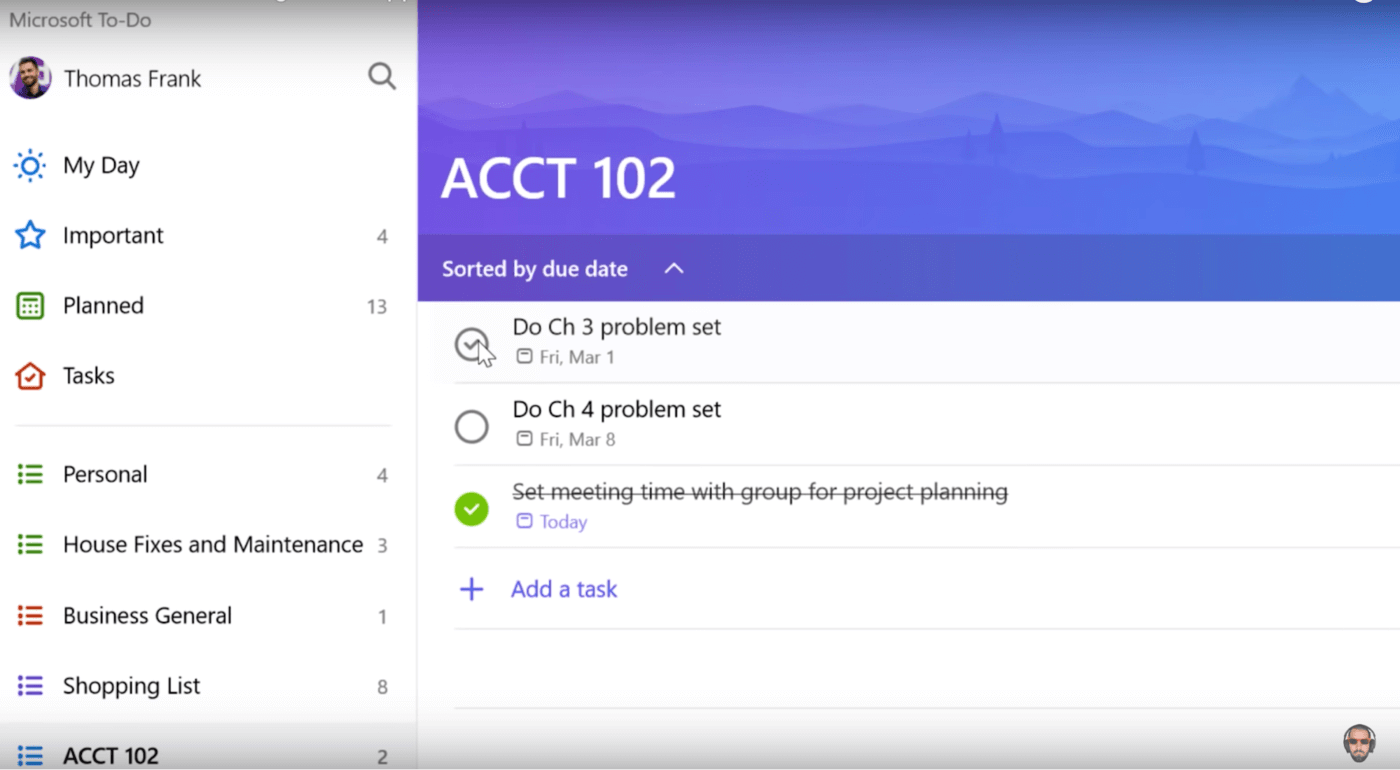
Overview
If you're looking for a free to-do list app that plays well with other Microsoft apps, then Microsoft To-Do is a great choice. The app has all the basic to-do functionality you need, though it does lack some "nice to have" features such as tags and natural language processing.
Compatibility
- Browser
- Mac
- Windows
- Android
- iOS
Pricing
- Free
Pros
- TOTALLY free. Touted as Microsoft's Wunderlist replacement, Microsoft To-Do's free features stack well against Todoist's paid ones. For example, Todoist's free plan doesn't allow for reminders, calendar syncing, and file attachments, while Microsoft To-Do allows all of that for free.
- Subtasks work well. Unlike Todoist, Microsoft To-Do turns subtasks into "Steps" (a.k.a. "checklist") for a parent task. Each step can have its own due dates and notes.
- "My Day" feature. This feature is similar to other apps that automatically organize your to-do's for today into one place. The difference is that Microsoft To-Do's "My Day" view starts out empty and lets you manually add tasks to the list.
- Quick Add widget in Android notification. Good for capturing tasks quickly. (At least on Android).
Cons
- No natural language processing I guess this is Microsoft's way of saying, "Hey, it's a free app. Be thankful."
- No tags, filters, and smart lists. MICROSOFT WHAT ARE YOU DOING?! YOU WERE SO CLOSE. For organization, Microsoft To-Do lets you make separate lists, but other than that, there's no way to tailor the app to your current workflow.
- Outlook-only calendar integration. I'm willing to bet my 5 internships that unless you work at a big company, you don't use Outlook. Which means you'll want a Google or Apple Calendar integration. Which you won't get with this Microsoft app.
Wondering which app is best among these three? Check out our review video:
4. Google Tasks

Overview
Google Tasks is a great to-do solution if you want an app that's no-frills and works perfectly with other Google apps (particularly Gmail and Google Calendar). It does, however, lack the organization features that come standard with many other to-do apps.
Compatibility
- Browser
- Android
- iOS
- Chrome
Pricing
- Free
Pros
- Google. Tasks strength relies on its integration with Google's suite of apps. For example, using Tasks on mobile or the web is great for quick capture, especially if you get a lot of tasks via Gmail.
- Best Google calendar view. Seeing, checking off, and updating my tasks for each day as I'm flipping through my Google Calendar is a time-saver. If you add a time to the task, it'll even show up within your agenda and block off that time for you.
- "Clear completed tasks" button. Seeing all the finished tasks get whisked away with a click sends a surge of fulfillment. I'm surprised no other app has this feature because it keeps things really clean.
- Subtasks. Really great for batching like tasks and then scheduling them all into one afternoon. Unlike more powerful apps, though, subtasks in Google Tasks don't function as individual ones (e.g., you can't set due dates for subtasks).
Cons
- Slow development. Tasks is an app that has been neglected for most of its existence. I used Tasks for 75% of my undergrad career, and only in my last year of university did they come out with a barebones Android app.
- No recurring tasks. The biggest reason why I stopped using Tasks. As of this writing, though, you can import recurring reminders from Google Keep into tasks. Baby steps.
- No organization. It's easy to just add tasks and use the app as storage for them, without executing on anything. It doesn't help that Tasks either sorts to-do items manually or by due date, then by name.
5. WorkFlowy
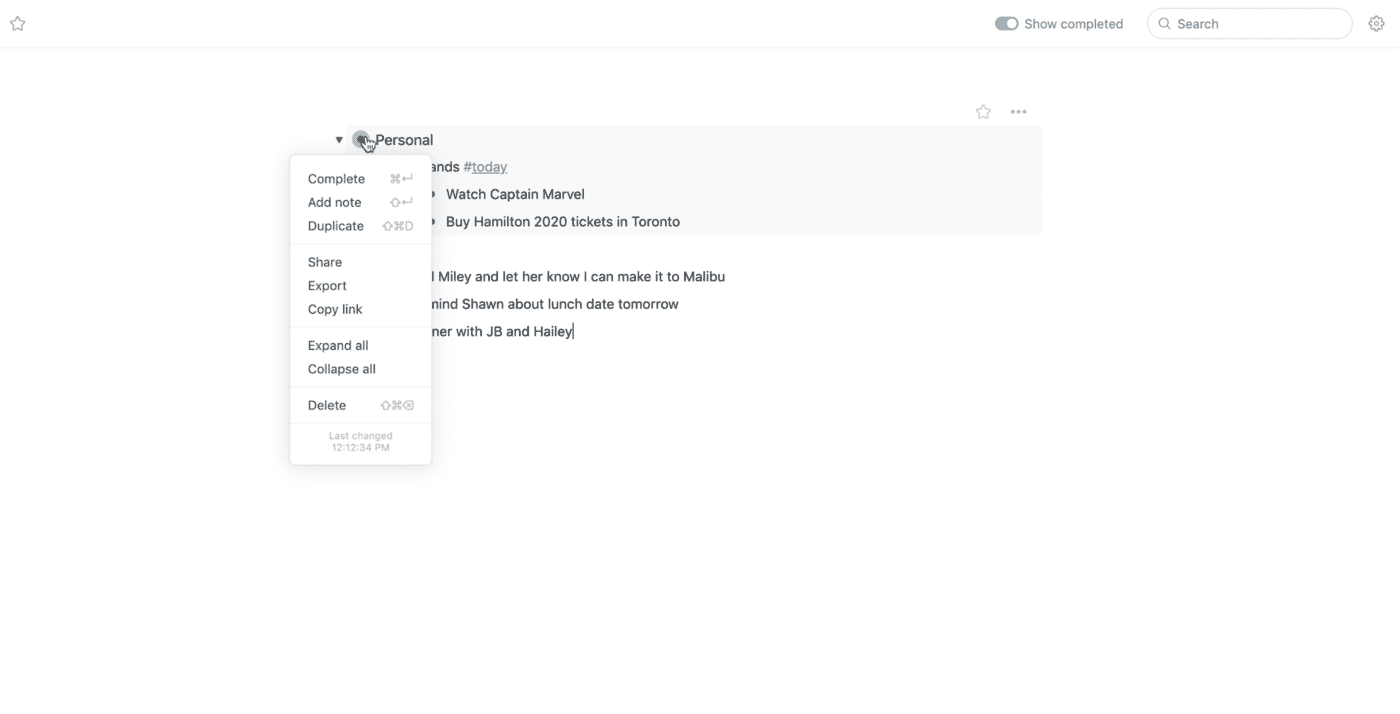
Overview
If you just need an app that will let you make lists and check things off, then WorkFlowy is an excellent solution. It lacks some standard to-do app features such as due dates, but it's still a useful app for tracking and completing quick to-do items.
Compatibility
- Browser
- Linux
- Mac
- Windows
- Android
- iOS
- Chrome
Pricing
- Free tier (limited features)
- Premium tier at $49 per year or $5 per month
Pros
- Roll-up feature. WorkFlowy is the original bullet-list app with its core roll-up feature for sub-bullets. All you have to do is click a bullet and all the sub-bullets beneath it roll-up into the higher one.
- Quick capture. WorkFlowy is great for capturing and outlining thoughts during brain dumps. It doesn't force you to pick between adding subtasks or notes. Just dump 'em all in there and decide later.
- List duplication and sharing. As simple as it is, WorkFlowy lets you duplicate, say, travel checklists for different trips and share those with your friends to make sure you don't forget the
beerwater for spring break. - Tags. Despite being as barebones as possible, WorkFlowy allows tags like #soon, #now, and #15min, all of which help with searching notes.
Cons
- Just lists stuff, and doesn't help you DO stuff. WorkFlowy is great at managing lists, period. But unlike similar apps such as Dynalist and TaskPaper, there's no native calendar syncing — which is essential to know when you actually want to do your tasks.
- No file browser. Unlike Dynalist and TaskPaper, WorkFlowy doesn't have a file browser to organize your lists into projects or folders.
- Free plan is limited to 250 lists or items per month. This shouldn't be a con because developers need to make money, too. But this limit pales in comparison to Dynalist's, which lets you have unlimited items and docs on the free plan.
6. Dynalist
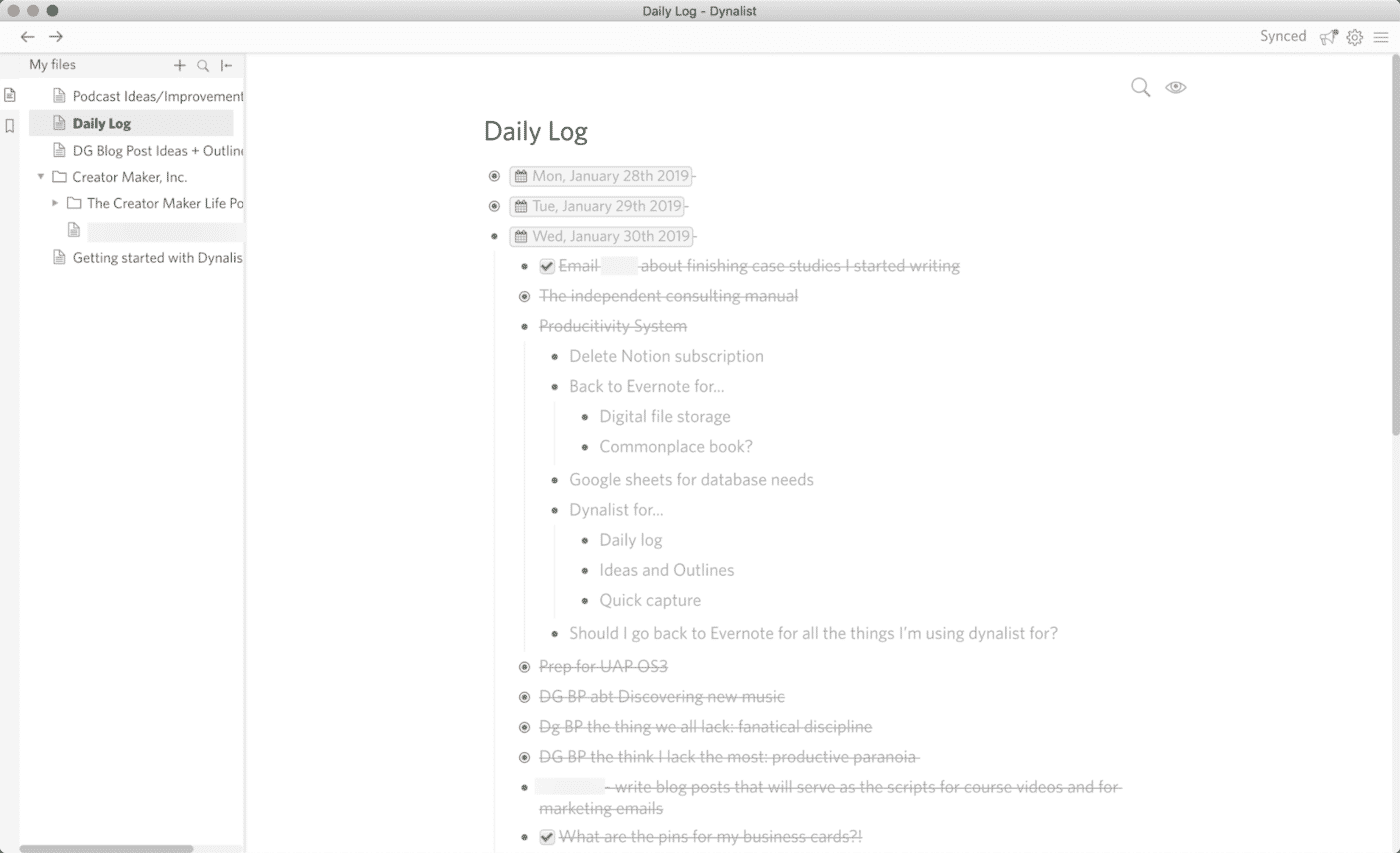
Overview
Dynalist is in many ways similar to WorkFlowy, except that it includes many of the standard to-do app features (due dates, recurring tasks, calendar integration) that WorkFlowy lacks. If you like the WorkFlowy interface but need a bit more organization, then Dynalist is a great choice.
Compatibility
- Browser
- Linux
- Mac
- Windows
- Android
- iOS
Pricing
- Free tier (limited-features)
- Premium tier at $84 per year or $9/month (50% off with a student discount)
Pros
- Free Tier is usable. You get unlimited items and docs. At least, it's better than WorkFlowy's.
- Has everything WorkFlowy doesn't. Not trying to bash WorkFlowy here, but Dynalist has all the features that WorkFlowy doesn't: file-browser navigation, due dates, recurring tasks, and calendar integration.
Cons
- Formatting gets wonky if you copy-paste outside of the app. Same as WorkFlowy. If you use Dynalist to outline your essay and paste it to write it elsewhere, you'll face a major PITA in reformatting.
- Mobile app is harder to use. Clicking on subtasks on Dynalist often takes me to the main task's page instead of the subtask. Frustrating.
7. TaskPaper

Overview
If you need an app that plays well with the Mac ecosystem and doesn't require a subscription, then TaskPaper is a great option. It keeps the "page-oriented" design of both WorkFlowy and Dynalist, but it adds some additional features such as natural language processing.
Compatibility
- Mac
Pricing
- $24.99 after a 7-day trial
Pros
- Best list app for managing tasks on Mac. TaskPaper's core functions are identical to WorkFlowy and Dynalist. Unlike WorkFlowy and Dynalist, TaskPaper was built to be a to-do list, first and foremost. This means it has a couple of extra features that the previous two don't have (more on that later).
- Better organization. In Dynalist and WorkFlowy, tags are just to categorize stuff. In TaskPaper, tags can be used to add context to a line item, such as a due date, or to identify it as a project in its file browser if you put a colon at the end.
- Basic natural language processing (NLP) for dates. In addition to organizing, tags in TaskPaper let you set due dates (@due) and start dates for tasks (@start) with basic NLP. The start date feature is a pretty advanced one, something that even Todoist doesn't have.
- Native integration with Reminders and OmniFocus. The integration with Reminders means one less app to download on your phone. And if you prefer to use another Apple-only app like OmniFocus to manage all your tasks, it's a cinch to integrate TaskPaper into your system, too.
Cons
- Mac-only. It doesn't have a mobile app. (Maybe the Reminders integration is a cop-out to save money developing a mobile app. 🙃)
- No recurring tasks feature. It's still a list-making app. What can you do? (Don't worry — everything else on this list will have a recurring tasks feature!)
- Unusable after free trial (unless you pay). The upside is that the fee is a one-time thing, not a subscription. Because of this, TaskPaper's paid plan is cheaper than Dynalist or WorkfFlowy's.
8. ClickUp
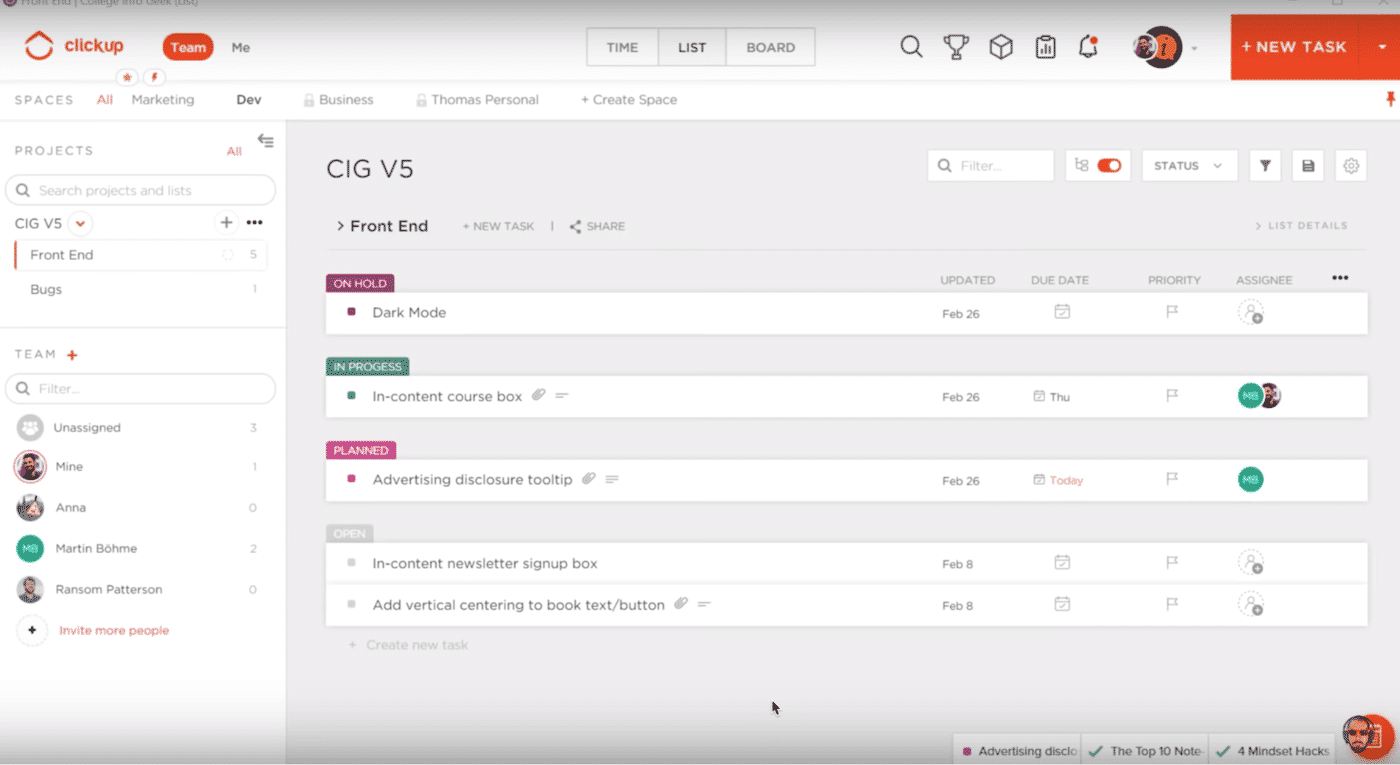
Overview
ClickUp is a great app to use if you like being able to visualize tasks and projects in a lot of different ways. In addition, you'll find all the standard task management features you'd want in a to-do list app.
Compatibility
- Browser
- Android
- iOS
- Amazon Fire
Pricing
- Free tier (limited to 100 MB of storage)
- Premium tier at $80/year or $12 per month (though the free plan should be enough for most students)
Pros
- Tons of ways to view and manage tasks and projects. There's a list view, a Trello-like board view, calendar view, and a Gantt chart view (a.k.a. timeline). There's time tracking, subtasks, due dates, recurring tasks, and even a "Watch" function (so you can see if your group member actually did their part of the project).
- Checklists. You can automagically generate templates for recurring tasks. This way you can stop forgetting that your liberal arts class's semi-weekly essay uses MLA, and not APA.
- Notepad feature. This is great for scratch notes, including a Chrome extension to get screenshots and add them to tasks.
Cons
- Friction in capturing and processing new tasks. It takes a lot of upfront thinking to figure out where tasks should go/be categorized, especially when you're rushing out the door to your next class.
- Android doesn't work offline. 🙁
9. Things
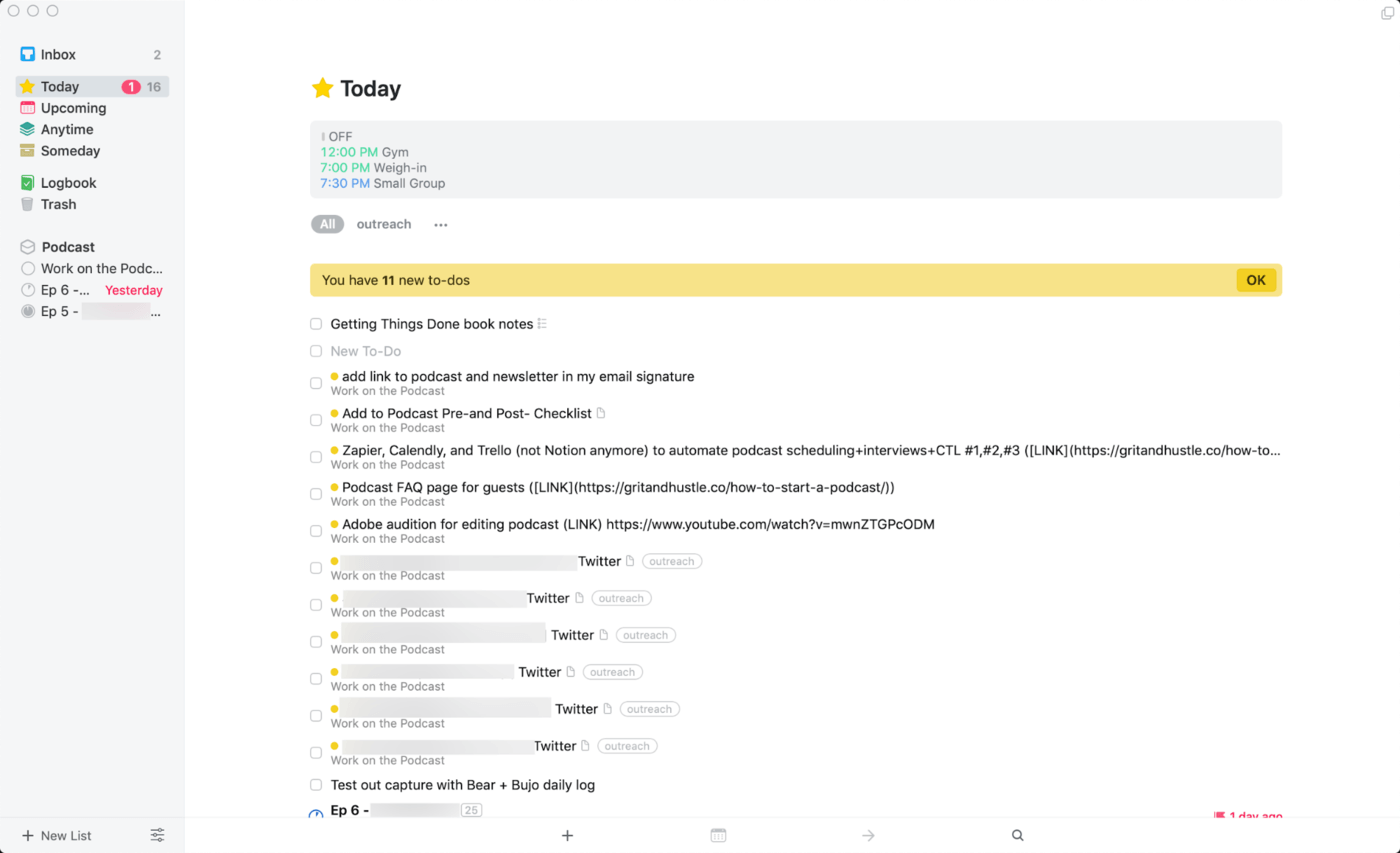
Overview
If you need a to-do list app that can do basically "all the things," then Things is the app to go with. Things looks a lot like Todoist, but it has a lot of "under the hood features" for managing far larger, more complex projects.
Compatibility
- Mac
- iOS
Pricing
- One-time fee of $50–$80 (depending on which iOS devices you use):
- $50 for Mac
- $10 for iPhone and Apple Watch
- $20 for iPad
Pros
- Powerful + well-designed. Things is the task management app that has so much functionality under the hood that entire courses are made for it. At the same time, it looks and functions as simply as Todoist.
- Most intuitive to-do app. Things was designed with the messy human brain in mind. For example, it lets you drill down your life from high-level areas and projects, all the way down to nitty-gritty checklists for subheadings within tasks.
- Best due-date/do-date application. This feature is essential for juggling multiple projects. For each task, you can set a start date and a deadline and it appears in the Today view on its start date.
- Task templates. Task templates are an essential but neglected feature, especially for those of us who have recurring projects with similar requirements every week.
- Repeating projects. With Things, you can set recurring start dates for tasks or projects that automatically populates the page with everything you have to.
- Create projects from tasks. A small, but lovable feature. This is for those times when you enter "Study for Exam" and realize that it'll take more time than just the studying itself.
Cons
- Apple-only, including calendar integration There's no native calendar integration aside from Apple's. The developers don't really control whether or not the app plays well with other calendars apart from Apple's.
- Limited natural language processing. Except for dates, for a premium app, it's disappointing that Things doesn't have NLP for projects and tags. Dealbreaker for some people.
- Separate purchases for desktop and mobile apps for Mac, iPhone, and iPad. I'll be honest: this annoyed me. Couldn't you have just one payment for both iPhone and iPad at least? (Still cheaper than the next app on our list, though).
10. OmniFocus
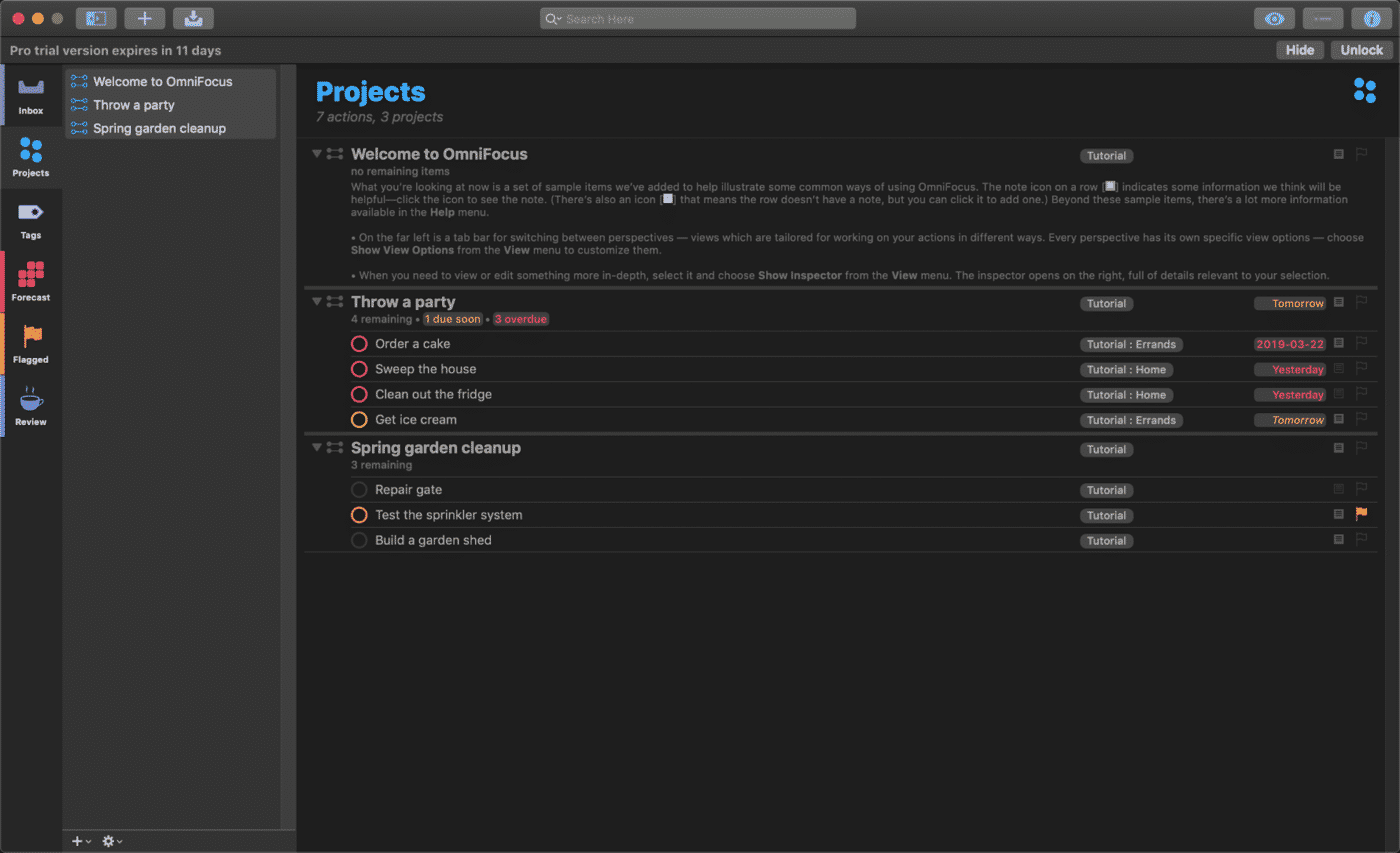
Overview
If you love the Getting Things Done (GTD) approach to productivity, then OmniFocus is the app for you. The developers took extra care to build an app that mirrors GTD, though the resulting app has a pretty steep learning curve.
Compatibility
- Mac
- iOS
Pricing
- Standard:
- One-time payment of $50 for Mac app
- One-time payment of $50 for iOS app
- Pro:
- One-time payment of $100 for Mac app
- One-time payment of $75 for iOS app
Pros
- Most powerful app on this list. OmniFocus closely follows David Allen's Getting Things Done philosophy. It lets you input as much data as possible so you can execute that system.
- Review perspective/view. For every project, you can input custom review intervals or just stick with your default project review cycle.
- Defer (when to start working on a task) and due dates. OmniFocus applies this feature to recurring projects and tasks, too. Imagine putting in the due dates for all your assignments, projects, and exams at the beginning of the semester, including when you want to start working on them. No need to worry about forgetting to start another project.
Cons
- Steep learning curve. I test drove OmniFocus and Things simultaneously and found myself picking up Things more quickly. Learning OmniFocus gave me a huge headache that lasted for a day.
- Confusing jargon. This is one reason why OmniFocus is so hard to learn — it needs its own dictionary. For example, calendar view = Forecast. Its start and due dates = defer dates and due dates, versus Things' simpler start dates and deadlines.
- Meh aesthetic and unintuitive design. I struggled with adding and processing tasks in OmniFocus because there's so much data to input, from the tags to the review date.
- Apple-only ecosystem. Similar to Things, there's no 3rd party calendar integration, aside from Apple's.
- Priciest. If you get the Standard license (doesn't do custom perspectives/views) for Mac and iOS, you're spending $100.
11. Asana
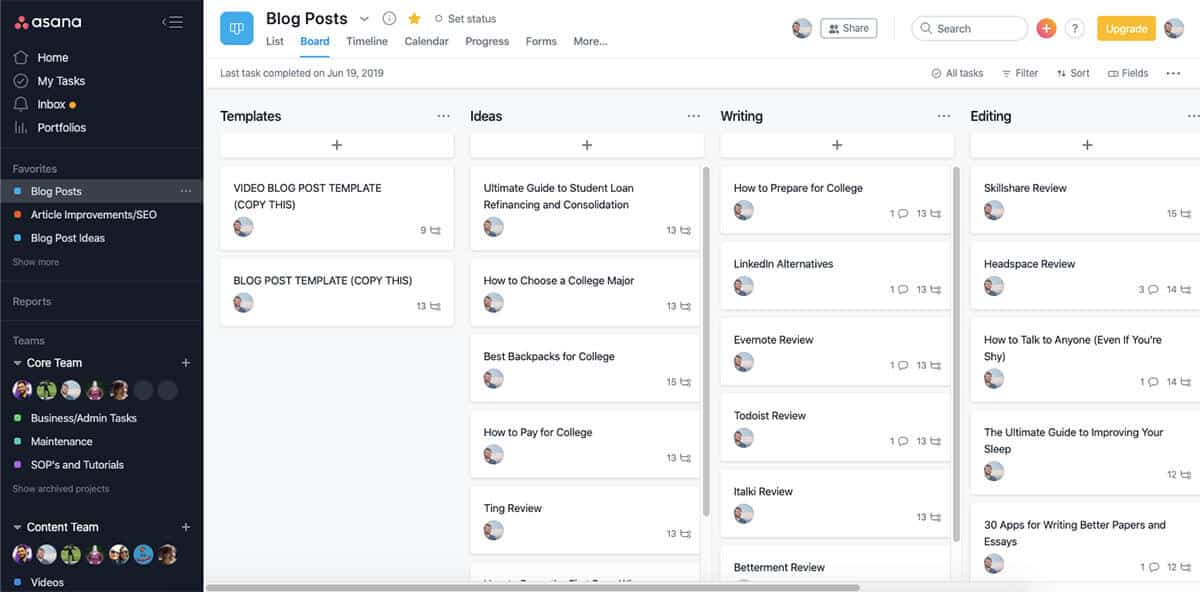
Overview
Asana is a robust to-do list and team productivity app. While it's designed to help teams manage large projects, you can also use it to manage your personal tasks.
Compatibility
- Browser
- Android
- iOS
Pricing
- Free tier (enough features for individuals)
- Premium tier starting at $10.99 per month, per user (has features that are helpful for teams but unnecessary for individuals)
Pros
- Choice of kanban or list view. Asana gives you the flexibility to visualize your tasks the way you want. If you're more of a visual thinker, then you can arrange your tasks in kanban-style columns. But if you prefer a more traditional list-based view, Asana offers that as well.
- Effective for organizing large numbers of tasks. If you have lots of different projects going on, Asana makes it easy to keep them all organized. You can break projects down into tasks, which you can then further break down into subtasks. This could be great for a student working on a thesis or an entrepreneur creating an online course.
- Comments to keep track of your progress. Asana lets you leave comments on any task you're working on. While this is meant to help teams stay up to date, it's also an effective way to leave notes to yourself.
Cons
- Can be overkill for individuals. In our experience, Asana shines when you use it with a team. If you're just keeping track of your personal tasks, many of the communication and collaboration features in the app are unnecessary.
- Interface can get cluttered. While Asana is great for managing large, complex projects, the interface can get cluttered and difficult to navigate if you aren't diligent about keeping tasks updated.
12. Apple Reminders
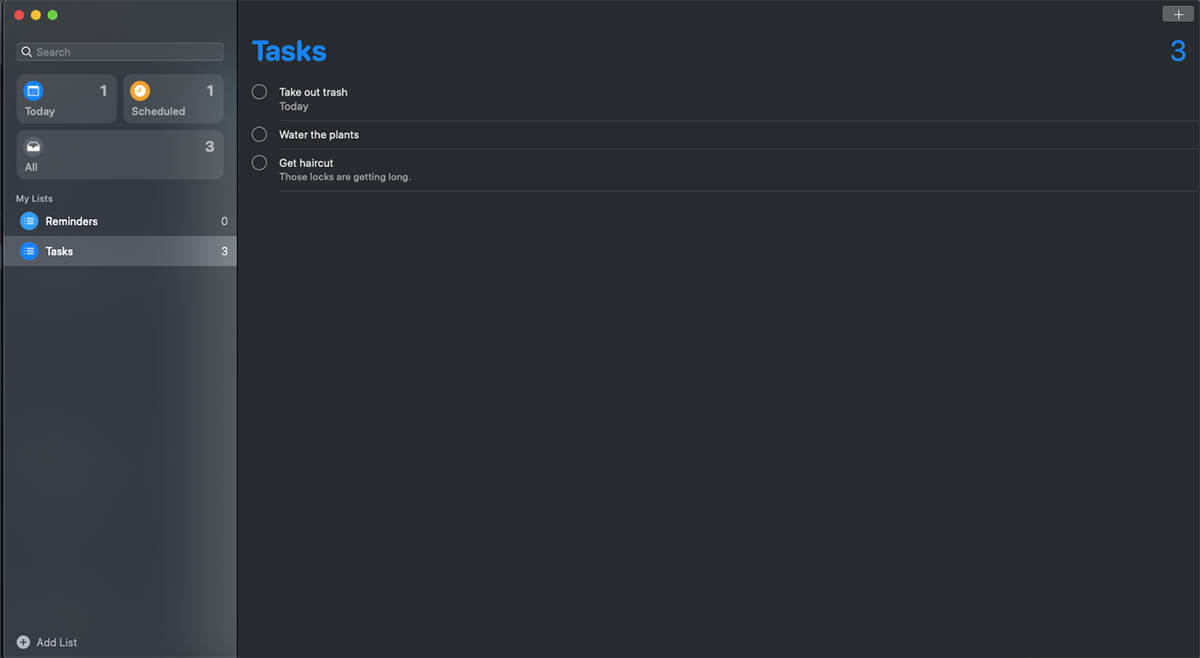
Overview
The name "Apple Reminders" is deceptive. While the app does let you set quick reminders on your Apple devices, it also offers productivity features such as subtasks, file attachments, and multiple task lists.
Compatibility
- macOS
- iOS
Pricing
- Free (with Apple devices)
Pros
- Integration with iCloud and the Apple ecosystem. If your phone and computer are both Apple devices, then you already have Apple Reminders — no need to download an additional app. And since Reminders stores all its data in iCloud, you don't need to create any new accounts.
- Location-based reminders. Reminders lets you set notifications for tasks based on where you are. You can even create preset locations such as "Home," "Work," and "Getting in Car."
- Apple Watch support. You can create and view Reminders tasks right on your Apple Watch by typing or using Siri.
Cons
- Apple-only. If you have an Android phone and a MacBook, for instance, you can't view or control reminders across your devices.
- No tags. While you can add descriptions to each reminder, there's no way to use tags to mark their status. This can be an issue if you're trying to add more context to tasks.
Which To-Do List App Should I Use?
All of the above information is great, but what if you just want us to tell you what app to use? Because needs and budgets vary from person to person, we couldn't pick just one "best" app.
But here are our top three recommendations for different situations:
1. Simple and Free
If you…
- Don't want to pay for anything and just want something simple
- Use Google Calendar
- Have a Windows computer + iOS device OR Mac + Android phone
…then go with Google Tasks (and maybe throw in Google Keep for recurring tasks).
2. Advanced Features at an Affordable Price
If you…
- Are willing to pay for contextual features like tags
- Have tasks coming at you from all directions
- Value natural language processing when inputting tasks
…then go with Todoist.
It has all of the above features, plus sharing and collaboration tools that are functional enough for students and student group work.
3. Keep Complex, Long-Term Projects Organized
If you…
- Juggle multiple projects at once
- Need to keep track of multiple timelines
- Want an app that can do it all (and then some)
…then you can't go wrong with Things.
Want to learn about even more tools to help do your best work? Check out our guide to the best productivity apps.
Image Credits: notebook checklist
App to Keep Track of Study Hours
Source: https://collegeinfogeek.com/best-to-do-list-app/